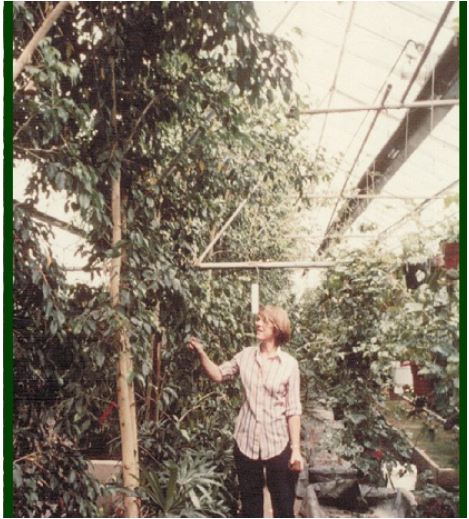
Nancy Ellen Brand Goldstein was born in August 15, 1936 in St. Louis, Mo. Her father was an entrepreneur in the steel industry, which allowed her to go to the best of schools that included Connecticut College for women and she graduated from Washington University in St. Louis, Mo. The original picture that was submitted to the CIPA office was of Nancy as a debutante when she was 16. Throughout her life she described herself as a tomboy enjoying most sports. She married a doctor who she met at Washington University and reared 3 children Gary, Kathy, and John. The family moved from St. Louis in 1964 to Fort Bragg, North Carolina. We stayed there for 2 years moving to the Los Angeles basin by the end of 1966. Will Rodgers formally owned one of the homes there. On August 15th 1968 the family relocated to Moraga, California where Plants Unlimited roots began in 1968-1969. At this time when we looked in the Bay Area yellow pages there were 3 other plant care companies. One of the companies was Decorative Plant Service, another was California Street Nursery, and then there was Plants Unlimited, Inc. Only one of those companies was primarily owned by a woman.
The amazing growth of Plants Unlimited, Inc. brought the company to San Lorenzo, California in August 15th, 1977. There we had acquired a rose range for cut flowers and every flower that we got to bloom had a so-called “guaranteed market”. That range also had extra square footage where we constructed greenhouses for the foliage for our service accounts and we expanded the production of our most exotic plants.
By 1978-1979, we bought Lyal Nickols inventory and his greenhouses. It expanded our inventory by variety and stature enormously. The purchase also opened the doors to the county fairs where would win a majority of the prizes for design, construction, specimen plants, the coveted horticulture and the best of show awards. It also allowed us to compete for the Bay Areas convention and special occasion short-term rental markets.
In the early 1980’s the volcano on Hawaii was spewing lava and many of the nurseries there were not insured. We flew in and had some of the uninsured contract grow for us. We told them the style of how to position the cuttings i.e. staggered 4, 3’, 2’, and 1’ cuttings. We showed them a notching technique so the plants would have a stronger root structure and not easily be pulled from their grow pots. We discussed the benefits of growing the plants in an acclimated space so that the plants would ship better and survive easier in an interior space here on the “mainland”. We suggested a growth time for the different varieties and styles. We told them how much we’d like to pay for them, showing them how much they could make. It worked out really well! Over time it seemed like everyone on the Island followed that lead.
At nearly the same time period the roses from Columbia and Israel were shipping to the USA in groves because they didn’t have to heat their plants to get them here in time for Christmas or Valentines. In the rose business, if you miss Valentines you have a BAD year. This is also when the cost of gas and electricity was increasing 10 fold. It didn’t take us long to discover that we should phase out the roses and consolidate the Lyal’s inventory to the San Lorenzo facility. At the same time we had changed our heating system to low intensity infrared saving 80% of our BTU usage. We even had PG&E come by to see if we were out of business because that 10-fold price increase wiped out one of the largest nursery areas, which was San Lorenzo, in the country. In any case, not only did the infrared heat save us mega money, but caused the plants to grow better, bigger, and faster!
By the middle of the 1980’s, we saw that a large amount of our ex-employees were spinning off and beginning their own interior plant care companies. It didn’t require a large capitol outlay to start up interior plant company just a watering can, some scissors, and a duster. The interesting part was they’d like to pick Nancy’s brain for free information on how to be successful in their new endeavor and she’d help them with contract law or anything else that they asked. Beyond that they wanted to purchase their plants from us. At that time, we looked in the yellow pages and there were nearly a full page of plant care companies. We discussed shifting from the interior plant care emphasis to supplying that industry which we helped begin. At the same time, after acquiring Lyal’s, our sales to the retail nurseries were flying high, so there was not any difficulty in making our decision.
We ended up getting baskets from the Philippines, moss from Georgia, ceramics from San Jose, and leaf shines from New York. We became a one-stop shop for the plant care industry. In the early to middle 1980’s, we were touting a relatively unknown plant. That plant bloomed for 6 times longer than a chrysanthemum or azalea cost 3 times as much as the standard diet color spots. It reduced the installation and/or replacement cost by 12 times. The plant is, of course, the Bromeliad. In 1983, we used 2000 Aechmeas in the San Mateo County Fair, which cost us $3.00, and we sold for $5.00 at the end of the fair. There were 2 fights in the lines to purchase them from us. That garden ended up being the cover of the San Mateo County’s phone book. The price jumped to $10.00-$12.00 in the next 2 years and is now a staple of what is now called the interiorscape industry.
By the end of the 1980’s the economy was in the garbage and the decision to change our focus again was to intensify the sales to the retail nurseries. You see, as our economy goes down, the first people to be let go are the now called interiorscapers and/or service techs, because management figures that one of the secretaries or janitors can take care of the plants. This again would drive more nursery sales, as you know those new non-plant people would kill a lot more plants, perpetuating our sales.
In the early 1990’s as we developed our independent nursery sales, we were approached first by Orchard Supply Hardware to sell to them. When Andrew the hurricane hit in Florida, again we sent aid to the uninsured nurseries and gave them new focus. It was great timing for us as then Ace Hardware, Ernst Hardware, Longs Drugs, Payless Drugs, and Thrifty wanted our acclimated foliage and exotics. Of course, The Home Depot signed us on when they came west too. Through the 1990’s, while we were approached by Wal-Mart, Lowes, and others we wanted hold our growth and to align our products with the companies that we had already fostered a relationship. All the while we still would cater to the interiorscape industry, Nancy giving them the free advise and we would assist them in major installations or problem accounts. Through the 1990’s Nancy’s health was failing, as she was a long term diabetic. In 1993 she incurred a triple bypass, through 1994-1995 she had some toes removed and she was losing her dexterity in her extremities. By the end of 1996 Nancy had lost both of her legs below the knees and by 1997 she began dialysis.
In the middle of 1997 she had lost both of her legs just above the knees, but it seemed like she wore it well, she was quite a strong woman. I recall one-day Nancy had just gotten back from a therapist and called me to the front of the office. When I went outside my mother was walking down our long driveway on her new titanium legs with her arms stretched in the air like she had just won Olympic gold! Unfortunately, her heart failed the next week on December 7th, 1997.
Throughout Nancy B. Goldstein’s life she was an avid flora and fauna lover. Any wayward animal, plant, or child could find warmth in her sanctuaries. Those were here loves and her hobbies. When she traveled there were often cuttings or seedlings brought back in new suitcases that she had bought while abroad. From her samples we’d try to see what we could grow, that the interiorscape industry would have difficulty killing, and we knew at that point we could sell to those new flavors to an additional market place for that product. She looked forward to all of the association meetings that included ALCA (American Landscape Contractor Association) one of the first women to attend there meetings, CAN (California Association of Nurserymen), IPPS (International Plant Propagators Society) member of the Board of Directors for years, CLCA (California Licensed Contractors of America), and was anxious to help out in what became PIA (Plantscape Industry Alliance).
Since Mom’s death we have replanted the aviary at the San Francisco Zoo and it was dedicated to her in 2000. There is also a 5000 square foot garden dedicated to her in 2002 at the Alameda County Fair.
Our family appreciates the industry that she helped start honoring her in this fashion!
The Fairgrounds destroyed the garden that John donated in Nancy’s name and the company has begun to compete in those gardens again 22 years after the donation was made. On our Home page you can find the directory of the plant quality and services that we are known to provide.
